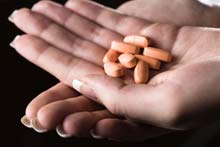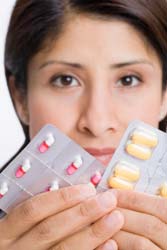Why are So Many Americans Being Poisoned by Prescription Drug Overdoses? And, the Surprising Group Who is Most at Risk …
Why might it include You or Someone You Know?
by www.SixWise.com
The rash of celebrity prescription drug overdoses that have hijacked media headlines for months signals a growing trend that spans way beyond the boundaries of Hollywood.
|

Hospitalizations from unintentional overdoses of prescription drugs have increased 65 percent in recent years!
|
Unintentional poisoning deaths from prescription drugs have been on the rise for years, and hospitalizations due to overdoses of prescription opioids, sedatives and tranquilizers increased 65 percent from 1999-2006, according to a new report to be published in the May 2010 American Journal of Preventive Medicine.
Researchers from West Virginia University School of Medicine analyzed data from the Nationwide Inpatient Sample, which includes data for about 8 million hospitalizations per year. Hospital admissions for opioids (morphine, OxyContin, etc.), sedatives and tranquilizers (Valium, Xanax, etc.) increased from about 43,000 to 71,000 during the seven-year study period.
“Deaths and hospitalizations associated with prescription drug misuse have reached epidemic proportions,” said the study’s lead author, Jeffrey H. Coben, M.D., of the West Virginia University (WVU) School of Medicine, in a WVU press release. “It is essential that health care providers, pharmacists, insurance providers, state and federal agencies, and the general public all work together to address this crisis.”
“Prescription medications are just as powerful and dangerous as other notorious street drugs, and we need to ensure people are aware of these dangers and that treatment services are available for those with substance abuse problems,” he continued.
Who is Most at Risk of Prescription Drug Overdose?
The problem of prescription drug overdoses is so severe that this poisoning is now the second leading cause of unintentional injury death in the United States. Among those aged 35 to 54, it is the leading cause of unintentional injury death, surpassing even auto accidents.
In fact, the majority of prescription drug overdoses involved women in this age group who lived in urban areas, and most were unintentional accidents.
As for why women are at an increased risk, Dr. Coben told iVillage Health:
“We're seeing an increasing number of self-harm attempts by women using prescription drugs. This may reflect what's seen in general for suicide attempts or drug overdoses that are intentional in nature: nonfatal suicide attempts more frequently occur in women.
Women also tend to see healthcare providers more frequently than men do, and the more contact there is with the healthcare system, the greater likelihood prescriptions will be provided. That also may be part of it.”
|

The more often you see your doctor, the more likely you are to be prescribed a medication -- and many medications are overprescribed.
|
Taking Prescription Drugs is Serious
So there are a number of reasons for the steep increase, including an increase in the use of pain and other medications. As Dr. Coben said, the more often you go to see your doctor, the more likely you are to be prescribed a medication. Sometimes these drugs are necessary, but often they are not.
Further, many people do not take the risks of prescription drugs seriously, and mistakenly believe that because they were prescribed by a doctor they are always safe. In reality, the risk of adverse drug reactions (ADRs) is can be very high.
As Dr. Coben told iVillage, “Use of prescription medicines is potentially dangerous. They are powerful drugs and it's important to use them only as they're prescribed by a healthcare provider.”
It is possible, however, to use a medication exactly as prescribed and still experience serious side effects. Reuters reported a study of nearly 10,000 adults who used at least three opioid painkiller prescriptions with a 90-day period to treat chronic pain. Fifty-one of them experienced at least one overdose and six died as a result. Further, as Reuters reported, the higher the dosage, the more likely an overdose was to occur.
Adverse Drug Reactions Common
The Journal of the American Medical Association reported that, in 1994, adverse drug reactions were between the fourth and sixth leading cause of death in the United States.
More recently, a study published in the New England Journal of Medicine found that one in four patients are plagued by side effects from prescription medications. Of the patients who experienced side effects (out of over 1,200 patients), 13 percent were serious (internal bleeding, low blood pressure, etc.). Another 39 percent were preventable or potentially treatable, such as a patient accidentally receiving a drug he or she is allergic to.
Other studies have also found that adverse drug reactions represent a serious risk to Americans. Findings include:
-
An estimated 5 percent of hospital admissions -- over 1 million per year -- are due to drug side effects.
-
ADRs were directly responsible for the hospital admission 3.8 percent of the time, yet 57 percent of them were not recognized by the physician at the time of admission.
-
18.6 percent of all drugs prescribed prior to hospital admission were contraindicated.
-
Up to 88 percent of ADR-related hospitalizations in the elderly are preventable.
-
Nursing home residents suffer 350,000 ADRs a year, according to the Institute of Medicine.
Unfortunately, many ADRs are never recognized for what they are, and the patient may instead be diagnosed with a new "disease.
Of course, ADRs and prescription drug overdoses do not only happen in the hospital. They can also happen at home, accidentally or on purpose. Among young people, for instance, prescription drugs are considered safer and less addictive than illegal street drugs, and are often taken recreationally for a quick, easy-to-obtain high.
New “Supplement Safety Act” May Encourage MORE Use of Dangerous Prescription Drugs
The Dietary Supplement Safety Act of 2010, introduced by Sen. John McCain in February 2010 (although he reportedly withdrew his support for the Act in March), was spearheaded by the use of supplements that were contaminated with steroids by Major League baseball players.
The contamination concerns were used to suggest that the FDA should be given additional power to regulated dietary supplements, even though the FDA already has the authority to remove contaminated supplements from the market.
The problem with the bill, if it is passed, is that it gives the FDA new authority to remove natural dietary supplements from the market. The FDA is often swayed by pharmaceutical company interests, and therefore may make decisions that benefit drug companies more than consumers.
For instance, the FDA recently approved a prescription version of fish oil, which costs about seven times more than the fish oil you can buy over-the-counter. The ultimate implications of this bill is not increased supplement safety for Americans, but the potential to lose access to beneficial dietary supplements that are currently sold over the counter.
How to Reduce Your Risk of Prescription Drug Overdose and Adverse Reactions
Ideally, the best way to reduce your risk of having an adverse reaction to a drug is to limit your exposure to them in the first place. This is something that can (and should) be done as a matter of course throughout your life by:
-
Eating plenty of health-promoting foods, and limiting junk foods. As you switch over to more fresh foods, we highly recommend you take advantage of the healthy and absolutely delicious recipes in the book “Alive in 5”: Raw Gourmet Meals in Five Minutes.
When prepared with locally grown ingredients from a source you trust, these are among some of the healthiest meals you can eat.
-
Getting enough sleep every night. Once you are in bed, listen to relaxing music or the excellent Sleep Easy CD to help you "shift gears" and relax into sleep.
-
Keeping stress to a minimum. For times when you need help putting your mind at ease, the Pure Relaxation CD will calm your mind, soothe your emotions and create a state of deep relaxation in your body. These meditations are unique in that they guide the listener to relax in a natural, effortless way.
-
Exercising regularly. If you’re looking for an exercise program you can do right from your own home, we highly recommend adding SheaNetics from MySheaNetics.com, a mind-body workout, to your exercise routine.
SheaNetics, founded by fitness expert Shea Vaughn, blends ancient and contemporary movements with eastern philosophy, creating a stylized approach to fitness designed to improve the quality of today’s western living.
Recommended Reading
Adverse Drug Reactions On the Rise: What You Can Do to Shield Yourself from the Dangers of ADRs
Teen Drug Use: Good News and Bad News Revealed in New Report
Sources
West Virginia University Health News April 5, 2010
Reuters.com April 6, 2010
ivillage.com April 7, 2010
DailyPaul.com February 10, 2010
LEF.org